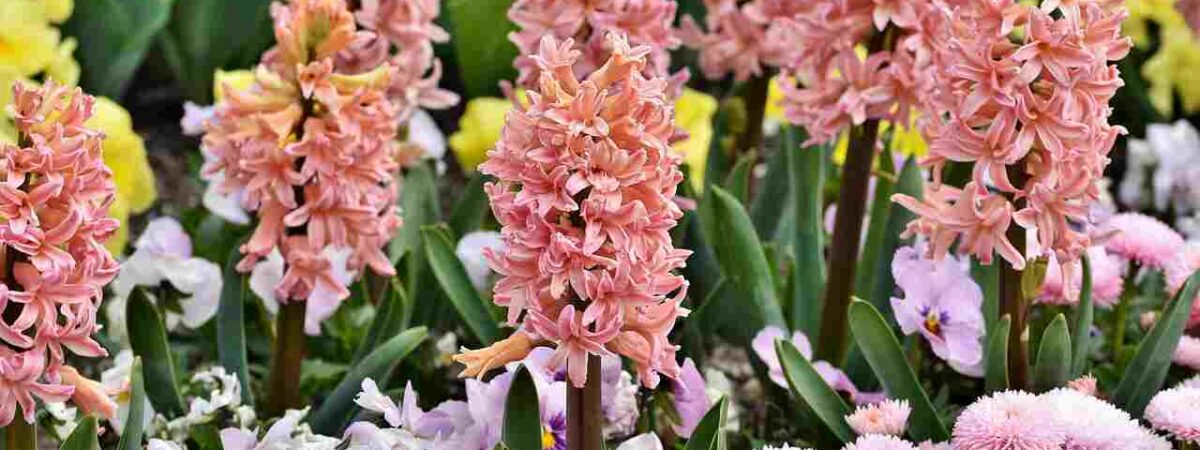Plant Overview
Hyacinths are beautiful, delightful, fragrant spring bulbs that are also very easy to grow. The flowers of this plant bloom in a variety range of shades, from traditional purple and pink to white and even mauve.
It is suggested to plant hyacinths at the front of garden borders or for pots as a spring display for a fragrant splash of color in your garden.
Hyacinths are flowering plants that can also be forced for indoor Christmas displays in the fall, they will bloom in mid-spring, filling your garden with a burst of pastel colors while most of the park is just waking up.
The flowers of the hyacinth are laden with natural perfume. Their fragrance is so intoxicating that they’ve been also called“nature’s perfume.”
Like most of the other perennial bulbs, hyacinths are also easy to grow and come back year after year. They are also beautiful plants for container gardens.
Let’s dive into the blog below to find out about the growing and caring guide for hyacinths.
Varieties of hyacinth

There are a lot of varieties of hyacinth present on the earth. Some of the important varieties are given below.
Hyacinth Orientalis ‘Blue Jacket’
This variety of hyacinths is one of the great blues of the flower world. It is an award-winning hyacinth variety that displays big columns of royal blue florets along with crisp white edges.
H. the Orientalis ‘City of Haarlem’
This is a beautiful heirloom variety of hyacinths that’s been popular since the late 1800s. The flowers of this variety are soft, primrose yellow, and maturing to creamy white.
H. Orientalis ‘Gypsy Queen’
Popularly recognized as the ‘Gypsy Queen’, this hyacinth variety is an heirloom hyacinth with salmon pink petals that have peach and buttery-yellow highlights.
H. Orientalis ‘Jan Bos’
Intensely fragrant, the award-winning hyacinth variety possesses Fuschia-pink color florets which are tightly packed into large flowerheads.
H. Orientalis ‘Miss Saigon’
Along with deep rich purple color flowers, this is a fragrant hyacinth variety that is covered with starry, gorgeous, and violet florets.
H. Orientalis ‘Pink Pearl’
The Rose-pink flower heads of this hyacinth variety turn heads with their cotton-candy sweetness. The ‘Pink Pearl’ variety is a favorite hyacinth variety for spring containers to add a pop of color.
Muscari armeniacum
This grape hyacinth variety bears small and delicate cobalt-blue flowers that look gorgeous when planted in masses.
How to Plant Hyacinths
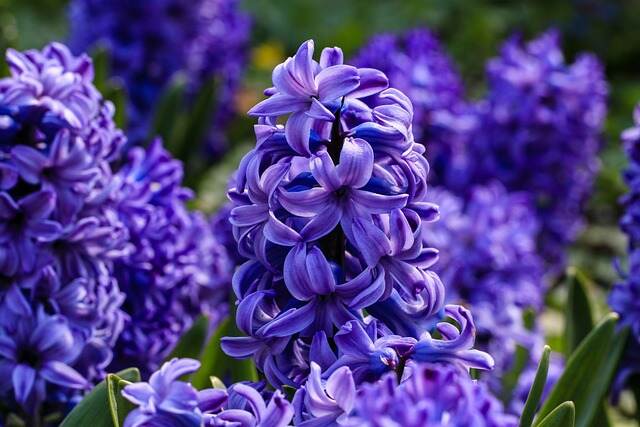
Like many other spring-blooming bulbs, hyacinth bulbs thrive to grow from mid-to-late autumn, any time after the first fall frost passes and before the ground freezes.
It is recommended to plant hyacinth bulbs 6” deep. Space your plant 5 to 6” apart. Hyacinth thrives to grow at the northern limits of their hardiness up to the USDA Zone 3, plant your hyacinth from 1 to 2 inches deeper to ensure winter hardiness.
If you want to plant 5 or more bulbs at the same time, it is suggested to dig out a larger area.
Hyacinths look beautiful when they are grown in groupings of 5 to 9 bulbs. The grape hyacinth variety also looks beautiful in masses and loose drifts. It is suggested to set the bulb in that hole with the pointy end up.
After planting cover your bulb with soil, and water it thoroughly. Apply a 1-to-2-inch layer of mulch around your plants to discourage weeds and disease in them.
If you are transplanting your plant, water sparingly and then don’t water again until the flower buds start to appear the following year.
Hyacinth bulbs contain a substance which is called oxalic acid, that may irritate the bare skin. So it is suggested to use gloves when handling these bulbs for a longer period.
How to care for hyacinth?
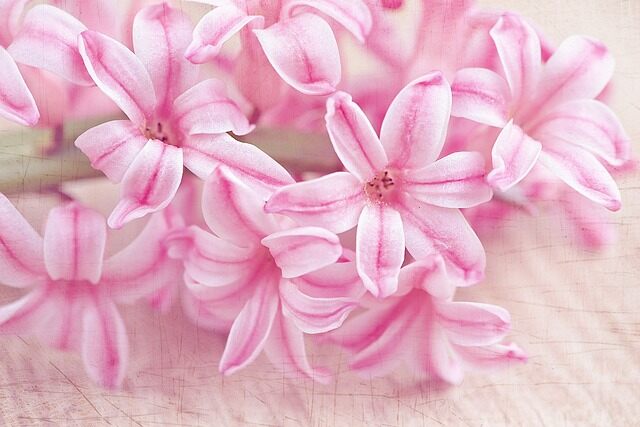
The following necessary steps could be taken for the proper growth of your hyacinth plant.
Light
Hyacinths like to grow in full sun to partial shade. So always aim to provide your plant with at least six to eight hours of sunlight a day. Just like other spring bulbs, hyacinths also sprout, bloom, and start to fade before any other deciduous trees fully leaf out, so you don’t have to worry if your plant is getting too much shade from nearby trees.
Soil
The bulbs of the hyacinth are not particular about soil pH, but they prefer to grow in a slightly acidic to neutral soil. They also do their best in soil which is loose and well-drained.
However, these plants are intolerant to wet soils. Rich soil can lead to floppy stalks of the plant, so you should go easy on the organic matter when preparing or amending the soil for the growth of these hyacinths.
Water
Hyacinth requires regular watering to grow. After you have planted the bulbs, Water the ground well. You should also continue watering your plant into winter if there is no steady rain, but make sure to allow the ground to dry out completely between watering.
The bulbs may eventually rot if they sit in cool, and wet soil. So check the ground at regular intervals by sticking your finger in, and water only when the soil is totally dry. Usually, you should do this once or twice a week, depending on your climatic condition.
You can add about 1/2 inch of water per week combined with irrigation and rainfall which will be sufficient for hyacinths. But this ultimately depends on how well the soil drains.
Temperature and Humidity
In general, Hyacinths can survive the winter in USDA plant hardiness zones 4 to 8. So they might require some protection from winter in colder zones and some pre-chilling in warmer zones, depending on the variety of the plant.
In those zones where the winter temperatures remain above 60 degrees Fahrenheit, you may dig up the bulbs and chill them somewhere dark and cold them for 6 to 10 weeks before replanting.
Fertilizer
The hyacinth plant might require some amount of feeding. The easiest way to feed your new bulbs is to toss some bulb food or fertilizer into the hole during planting. There are a lot of fertilizers available in the market for feeding bulbs. The 10-10-10 is recommended for your plant or else you can also use an ordinary bone meal.
Feed your bulbs a mere handful of fertilizer at planting and again in the spring when the new growth starts appearing by scratching some bulb food into the nearby soil and watering well. For the amount of fertilizer to use, you should follow the product label instructions.
How to propagate Hyacinth?
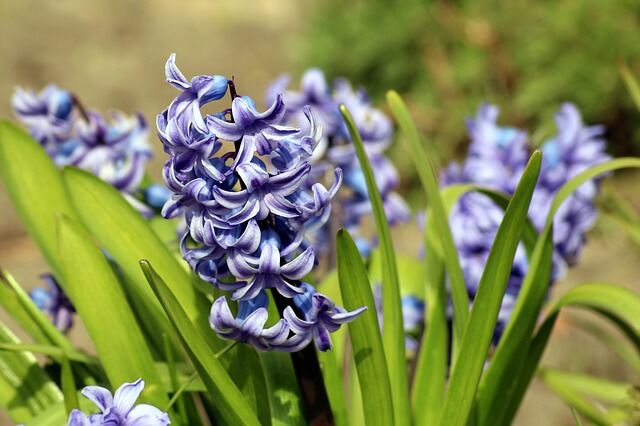
Like most of the other perennial bulbs, hyacinths are also propagated by splitting the offset bulbs from the parent plant during the fall. This propagation method can be done two or three years before the bulblet grows to a size that is sufficient to produce large, vibrant flowers.
Thus, propagating hyacinths is such an activity which best practiced by serious enthusiasts.
Below is the process of how to propagate hyacinths by splitting off the offset bulbs:
After the flowers of one of your hyacinth plants have faded but before the foliage has began to turn brown which is usually in late summer or fall, split up a mature hyacinth with a trowel from the plant. Make sure to wear gloves whenever you are handling hyacinths, as these bulbs have toxins that can also cause skin irritation.
Wash off the soil from the bulb, and separate the clump into several individual bulbs which may be the parent bulb and bulblets.
Replant your bulbs immediately into well-draining soil. Try to mix in sand or compost to the soil is a good idea if your soil is dense. You can use a handful of bone meal or other bulb fertilizer at the planting site is also recommended at planting time.
Conclusion
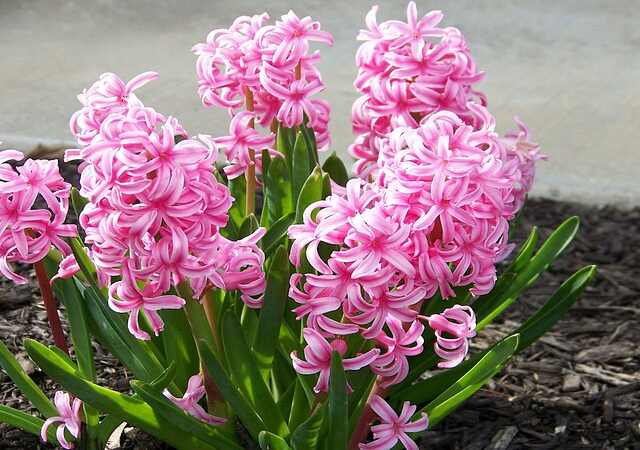
Hyacinths are indeed beautiful additions to your gardens. These flowering plants provide vibrant floral color along with tall spikes of eye-catching blooms and bright green foliage to your garden.
Apart from that, hyacinths are such perennials that produce striking, fragrant flowers, the type of plant which may you look forward to their blooms every year. The fragrance of the flowers makes another advantage to add it your garden.
As you read the article, you may learn about hyacinths and how to plant, tend, and maintain them everywhere. So grow them in your garden or container and let us know how it is going.
You may also like to read
How to grow and care for Mahonia – From planting to propagation

